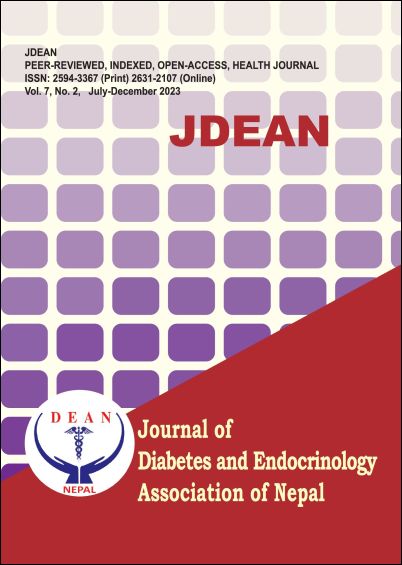The glycemic control and side effects of Empagliflozin on patients with type II diabetes mellitus in tertiary care Hospital
DOI:
https://doi.org/10.3126/jdean.v7i2.63887Keywords:
Empagliflozin, Glycemic Control, Follow up study, Type II diabetes mellitus, Side effectsAbstract
Background: Diabetes mellitus is a metabolic disorder characterized by chronic hyperglycemia associated with disturbances of carbohydrate, fat and protein metabolism due to absolute or relative deficiency in insulin secretion and/or action. The burden of it is increased globally especially middle- or low-income countries. Different oral anti-diabetic medicines including older regimen to novel medicine like empagliflozin are used for the treatment of different types of diabetes. This study was aimed to study the effects of empagliflozin on patients with type II diabetes mellitus in tertiary care Hospital, Nepal.
Methods: A hospital based prospective follow up study with purposive sampling was carried out for a period of six months from July to December 2022. A representative sample of more than 110 from prescriptions of T2DM patients aged between 20 to 60 years were observed for demographic details (age, sex, body weight, body height, body mass index (BMI) etc.), Hb1AC level, fasting plasma glucose (FPG), postprandial plasma glucose (after 2 hours) (PPG), blood pressure (SBP and DBP), adverse effects and an interview was conducted with Endocrinologist as well as patients who receive empagliflozin for first time and data were analyzed by using applicable statistical tolls.
Results: A total of 215 patients were prescribed empagliflozin 10mg tablet out of which only 110 patients came for the follow up at 6 months. Hence, 110 respondents completed the study with in the study period (n=110). Out of 110 patients, 56 (50.9%) were male and 54(49.1%) were female. The majority of patients belonged to the age group 51-60 years 55 (50%) with mean age of 48.89±8.81 years. The mean diabetic duration was 7 years. After 6 months of empagliflozin therapy there was significantly reduction in weight, BMI, blood pressure, anthropometric values (HbA1c, FPG, and PPG) with some suspected side effects were also observed.
Conclusion: Thus, the main aim of this research was to study the effects of empagliflozin on patients with type II diabetes mellitus in tertiary care Hospital, Nepal. The outcomes of this research will be used as the reference for the preparation of diabetes treatment guidelines, regimens and related policies in the future.
Downloads
Downloads
Published
How to Cite
Issue
Section
License
Copyright (c) 2023 The Author(s)

This work is licensed under a Creative Commons Attribution-NonCommercial 4.0 International License.
This license enables reusers to distribute, remix, adapt, and build upon the material in any medium or format for non-commercial purposes only, and only so long as attribution is given to the creator.




